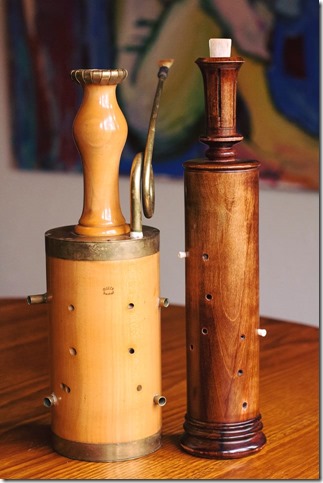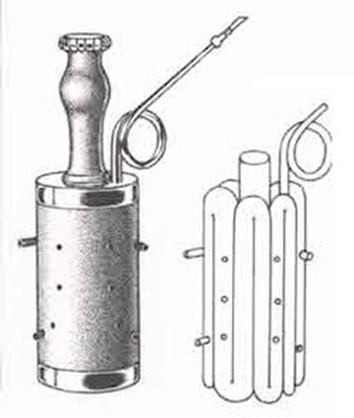Excerpted from the Unholy Rackett, a stellar music group discovered on Facebook. As I wished to share the info provided by the Unholy Rackett Facebook page to the Woodwind Forum I took some highlights from their Facebook page with the hopes they would be okay with the share. What a fab group.

The instruments shown in this photograph are both called ‘racketts’. However, they are only very distantly related to one another, and they never coexisted during the same historical period. Although superficially similar in appearance, they are as different from one another as a harpsichord is from a piano, a violin is from a viol, or a banjo is from a guitar. The fact that they are both referred to as ‘racketts’ today is a historical coincidence.
On the right is the instrument used in our video, the renaissance rackett.
The renaissance rackett is a double reed instrument with a narrow cylindrical bore, like a bagpipe chanter or a crumhorn. The bore is coiled nine times within the body of the instrument, emerging at the side of the instrument as a simple hole. The renaissance rackett’s large double reed is blown with the assistance of a pirouette, like that of a shawm. Due to their cylindrical bore, renaissance racketts play at 16’ pitch; that is, an octave lower than expected from the length of the bore.
Like all renaissance instruments, the renaissance rackett came in a family of sizes, from alto to great bass, famously depicted in Michael Praetorius’s Theatrum Instrumentorum of 1620.

The rackett seems to have appeared in the German-speaking states in the the 1570s. The earliest evidence we have for it is a miniature by Hans Mielich of the Bavarian Hofkapelle in Munich, ca1570, which depicts the composer Orlando di Lasso with a consort of singer and instrumentalists, amongst whom is a man playing a rackett. The first written evidence of a ‘Ragget’ was in 1576 at Ludwigsburg. Over the next half century they were variously referred to as Rageten, Ragecken,’Rogetten’ and ‘Racketten’. There is one tantalising reference to the renaissance rackett from France (Mersenne 1636), depicting what it calls a ‘cervelat à musique’ – a musical sausage. This is the only extant reference to a renaissance rackett outside the German-speaking states. There is no evidence that the word ‘Rankett’, used for an organ stop, was ever applied to the woodwind instrument in its day.
The renaissance rackett appears to have died out in the decades following the Thirty Years War, when German musical tastes shifted away from renaissance polyphony toward the new baroque style. Three original renaissance racketts survive, all made of ivory.
The instrument shown on the left of the photograph is a baroque rackett.
The baroque rackett probably appeared around 1700, and survived until around 1750. The baroque rackett is effectively a compact baroque bassoon, which has had its bore folded several times to fit inside a single billet of wood. It has a conical bore, the same as a baroque bassoon, uses a small lip-controlled reed the same as a baroque bassoon, and plays at the same pitch as the baroque bassoon (8’ pitch, with a compass of BBb – g). It was only available in one size, and was probably something of a novelty.
The folded bore gave it its German nickname, ‘Wurstfagott’, or ‘sausage bassoon’, and in French, ‘cervelas’, or ‘sausage’ (similar to the renaissance rackett). There is no evidence the baroque rackett was ever referred to by terms such as Ragget/Raget/Rageck/Rogett or Rackett during its day.
Several original baroque racketts survive, including some from well-known eighteenth century woodwind makers such as Robert Wijne from the Netherlands, and Charles Bizey from France, both of whom also made regular baroque bassoons.
Frequently Asked Questions
Is this instrument the origin of the English expression ‘to make a racket’? No. The rackett was unknown in English-speaking countries. It is purely a coincidence that these words look and sound the same. ‘Rackett’ is a German word meaning a ‘firework-shaped instrument’. It shares the same root word as the English word ‘rocket’.
Is the rackett the predecessor of the bassoon? No. Organologically speaking, the renaissance rackett is in a different family from the bassoon due to its bore shape. However, the baroque rackett is related to the baroque bassoon, and is descended from it. Chronologically speaking, the curtal or dulcian appeared ca. 1550, the renaissance rackett appeared ca. 1570, the baroque bassoon appeared ca. 1660 and the baroque racket ca. 1700.
Where can I buy a rackett? Renaissance racketts are made by Phil and Gayle Neuman in the USA, and All’Antica in Switzerland. Secondhand racketts by older makers (Moeck, Wood, Beekhuizen, Loraine) are occasionally available online.
As far as we aware, nobody is currently making baroque racketts. You might be lucky to buy one secondhand, but these instruments are essentially impossible to get. Hopefully a clever instrument maker will start making them again soon!
From the group: If you have a different interpretation of the primary evidence, or know of any new evidence that has come to light, we would love to hear from you. Thanks!
More pictures: https://www.instagram.com/unholyrackett/

The instruments shown in this photograph are both called ‘racketts’. However, they are only very distantly related to one another, and they never coexisted during the same historical period. Although superficially similar in appearance, they are as different from one another as a harpsichord is from a piano, a violin is from a viol, or a banjo is from a guitar. The fact that they are both referred to as ‘racketts’ today is a historical coincidence.
On the right is the instrument used in our video, the renaissance rackett.
The renaissance rackett is a double reed instrument with a narrow cylindrical bore, like a bagpipe chanter or a crumhorn. The bore is coiled nine times within the body of the instrument, emerging at the side of the instrument as a simple hole. The renaissance rackett’s large double reed is blown with the assistance of a pirouette, like that of a shawm. Due to their cylindrical bore, renaissance racketts play at 16’ pitch; that is, an octave lower than expected from the length of the bore.
Like all renaissance instruments, the renaissance rackett came in a family of sizes, from alto to great bass, famously depicted in Michael Praetorius’s Theatrum Instrumentorum of 1620.

The rackett seems to have appeared in the German-speaking states in the the 1570s. The earliest evidence we have for it is a miniature by Hans Mielich of the Bavarian Hofkapelle in Munich, ca1570, which depicts the composer Orlando di Lasso with a consort of singer and instrumentalists, amongst whom is a man playing a rackett. The first written evidence of a ‘Ragget’ was in 1576 at Ludwigsburg. Over the next half century they were variously referred to as Rageten, Ragecken,’Rogetten’ and ‘Racketten’. There is one tantalising reference to the renaissance rackett from France (Mersenne 1636), depicting what it calls a ‘cervelat à musique’ – a musical sausage. This is the only extant reference to a renaissance rackett outside the German-speaking states. There is no evidence that the word ‘Rankett’, used for an organ stop, was ever applied to the woodwind instrument in its day.
The renaissance rackett appears to have died out in the decades following the Thirty Years War, when German musical tastes shifted away from renaissance polyphony toward the new baroque style. Three original renaissance racketts survive, all made of ivory.
The instrument shown on the left of the photograph is a baroque rackett.
The baroque rackett probably appeared around 1700, and survived until around 1750. The baroque rackett is effectively a compact baroque bassoon, which has had its bore folded several times to fit inside a single billet of wood. It has a conical bore, the same as a baroque bassoon, uses a small lip-controlled reed the same as a baroque bassoon, and plays at the same pitch as the baroque bassoon (8’ pitch, with a compass of BBb – g). It was only available in one size, and was probably something of a novelty.
The folded bore gave it its German nickname, ‘Wurstfagott’, or ‘sausage bassoon’, and in French, ‘cervelas’, or ‘sausage’ (similar to the renaissance rackett). There is no evidence the baroque rackett was ever referred to by terms such as Ragget/Raget/Rageck/Rogett or Rackett during its day.
Several original baroque racketts survive, including some from well-known eighteenth century woodwind makers such as Robert Wijne from the Netherlands, and Charles Bizey from France, both of whom also made regular baroque bassoons.
Frequently Asked Questions
Is this instrument the origin of the English expression ‘to make a racket’? No. The rackett was unknown in English-speaking countries. It is purely a coincidence that these words look and sound the same. ‘Rackett’ is a German word meaning a ‘firework-shaped instrument’. It shares the same root word as the English word ‘rocket’.
Is the rackett the predecessor of the bassoon? No. Organologically speaking, the renaissance rackett is in a different family from the bassoon due to its bore shape. However, the baroque rackett is related to the baroque bassoon, and is descended from it. Chronologically speaking, the curtal or dulcian appeared ca. 1550, the renaissance rackett appeared ca. 1570, the baroque bassoon appeared ca. 1660 and the baroque racket ca. 1700.
Where can I buy a rackett? Renaissance racketts are made by Phil and Gayle Neuman in the USA, and All’Antica in Switzerland. Secondhand racketts by older makers (Moeck, Wood, Beekhuizen, Loraine) are occasionally available online.
As far as we aware, nobody is currently making baroque racketts. You might be lucky to buy one secondhand, but these instruments are essentially impossible to get. Hopefully a clever instrument maker will start making them again soon!
From the group: If you have a different interpretation of the primary evidence, or know of any new evidence that has come to light, we would love to hear from you. Thanks!
More pictures: https://www.instagram.com/unholyrackett/


